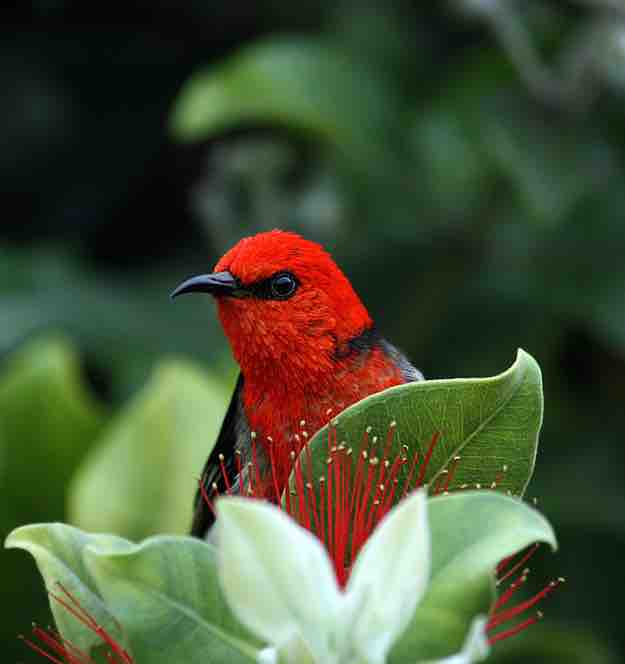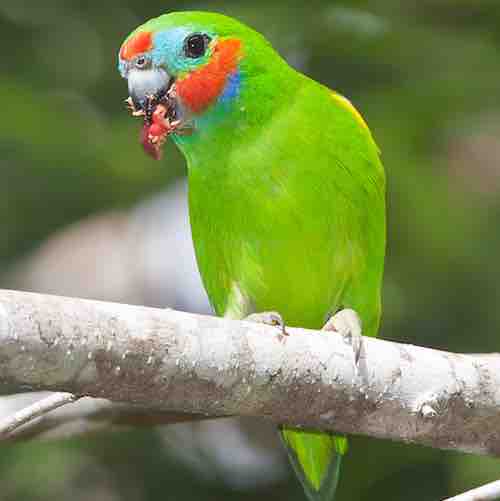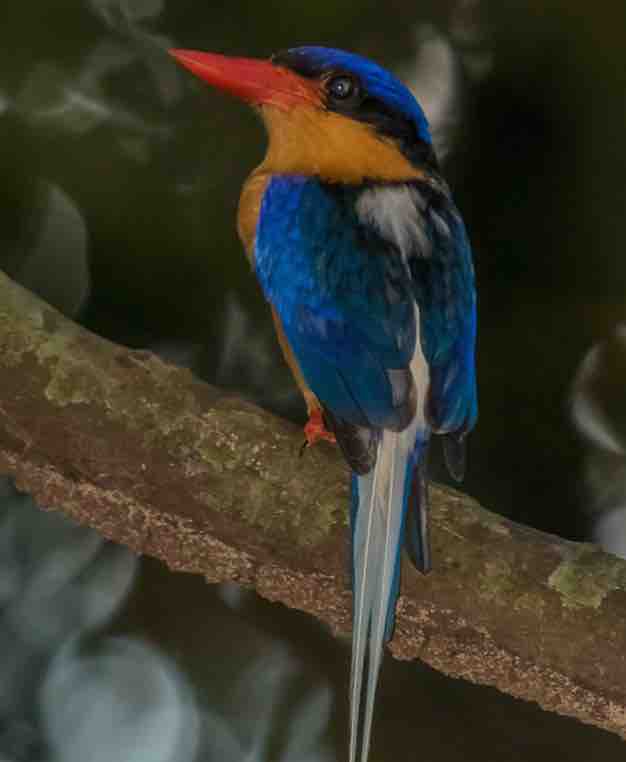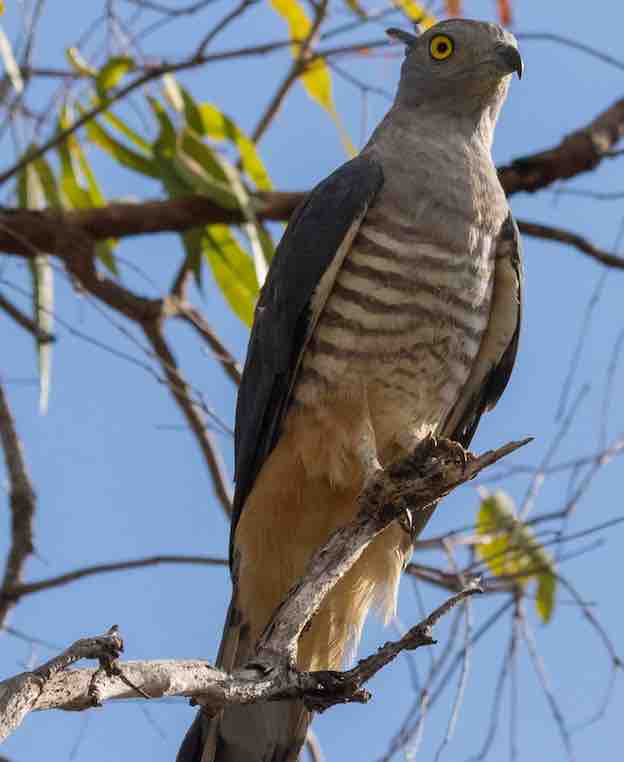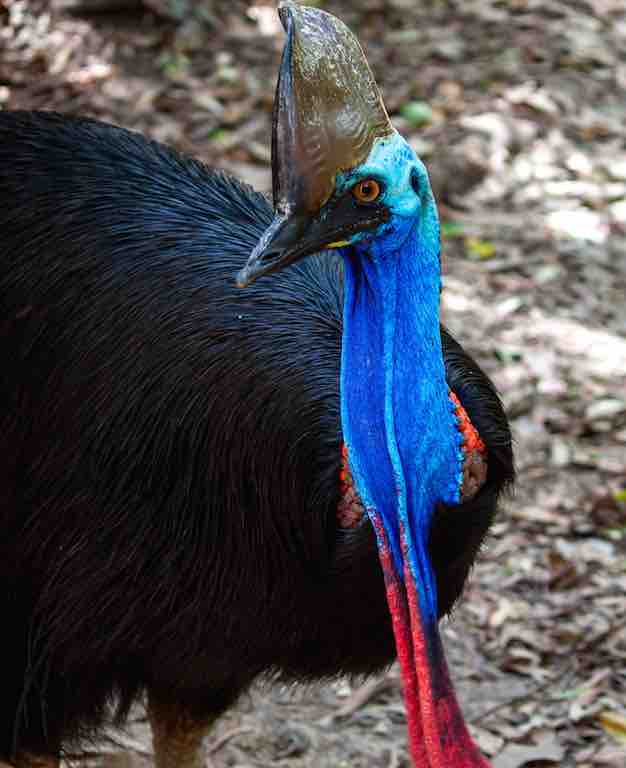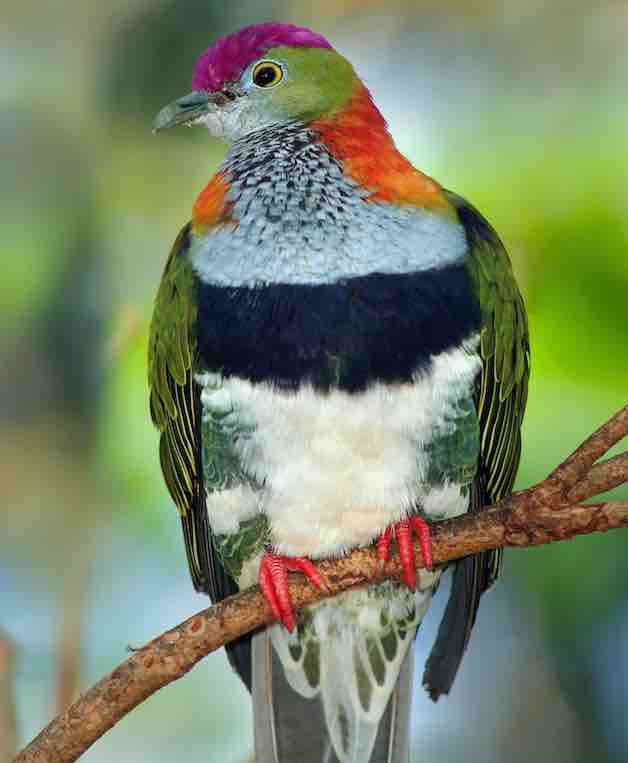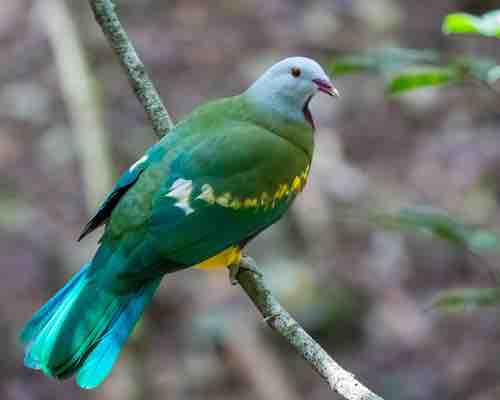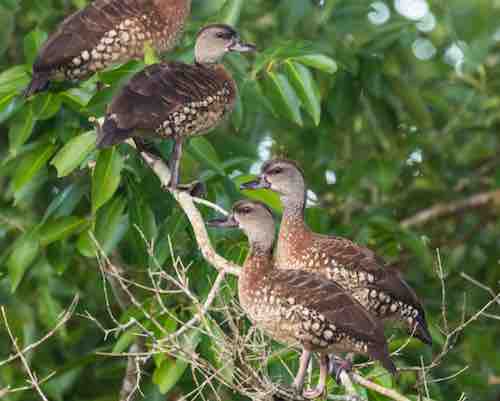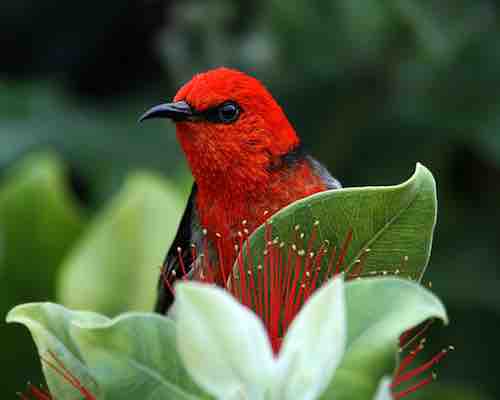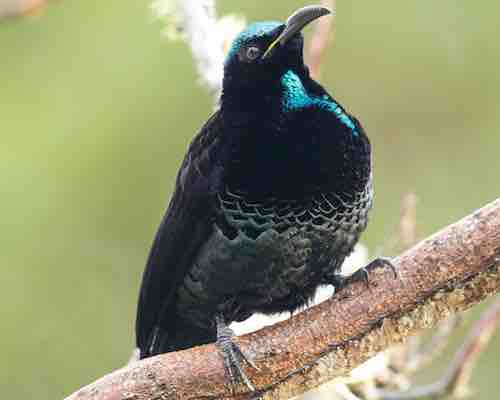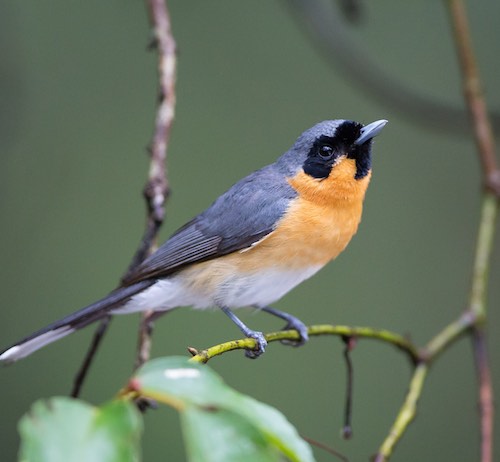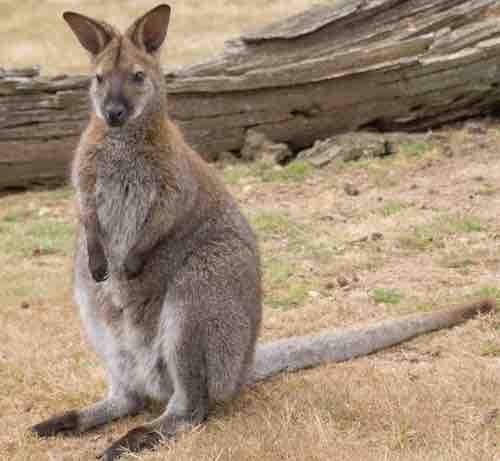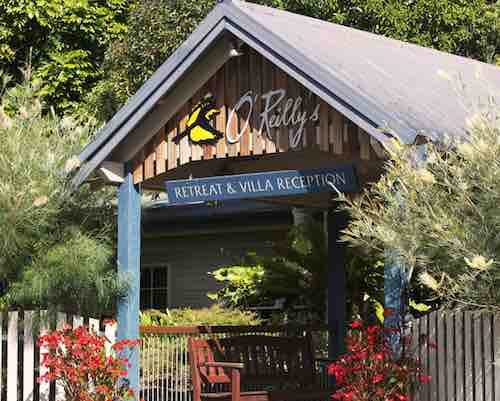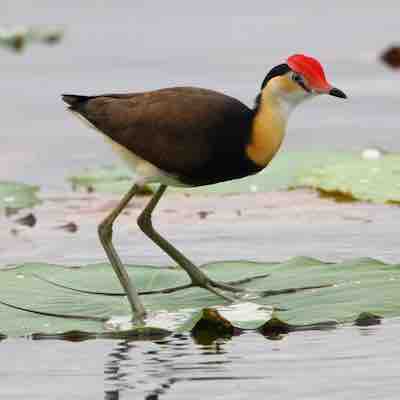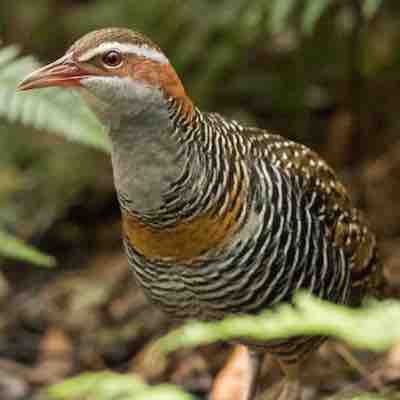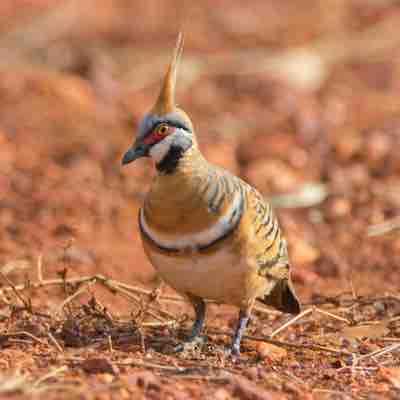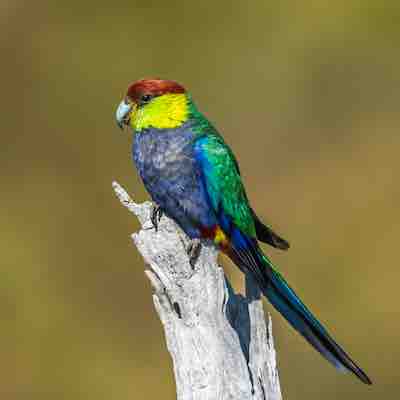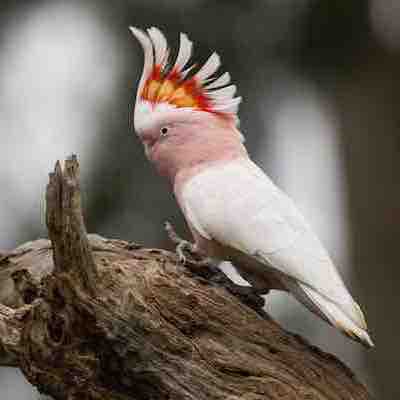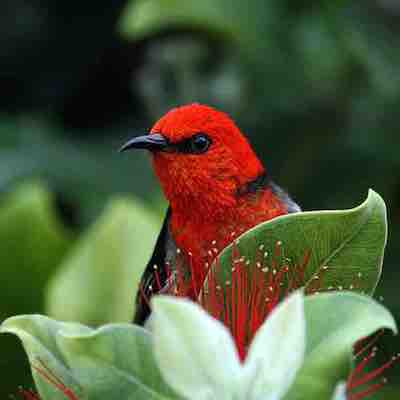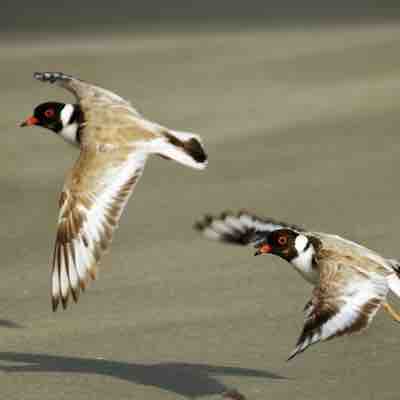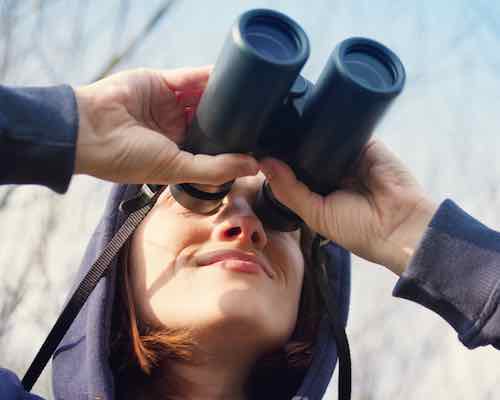birding in Queensland
Southern Queensland’s eucalypt forests, woodlands, grasslands, scrub, rainforests, heaths and wetlands hold a great number of species with specialties such as Albert’s Lyrebird, Paradise Riflebird, Logrunner, Red Goshawk, Pacific Baza, Black-breasted Button-quail and Eyrean Grasswren.
Northern Queensland has a count of around 490 species and its wet tropics produce a great range of rainforest specialties including Golden Bowerbirds and Southern Cassowary.
The dry areas produce Brolga and Sarus Crane, Black-throated Finch, and Gouldian Finch may be seen here. Unique to this area are Palm Cockatoo, Golden-shouldered Parrot, Yellow Honeyeater, Atherton Scrubwren, Fernwren, and seasonally, the beautiful Buff-breasted Paradise-Kingfisher.
Of course, you will want to view Pied Imperial-Pigeons, Victoria’s Riflebird, Chowchilla, Catbird, and Macleay’s Honeyeater.
Full Day Cairns Region (Wet Tropics) Birding Tour
The broader Cairns region is one of the most prolific areas for bird life in Australia with a diverse range of habitats such as rainforest, woodlands, mangroves, grasslands and lagoons. Over 400 species have been recorded in this region and 13 species are endemic.
A full day private tour with an expert local birding guide is the most effective way for twitchers and amateur birders alike to view a good number of species (often 90+) in a day.
You can choose to visit one of the following areas:
Atherton Tableland – concentrating on the Atherton and Mareeba areas, with sought-after possibilities including Victoria’s Riflebird, Spotted Catbird, Chowchilla, Tooth-billed Bowerbird, Golden Bowerbird, Yellow-breasted Boatbill, Scarlet, Bridled & Lewin’s Honeyeaters, Wompoo Fruit Dove, Comb-crested Jacana, Green Pygmy-Goose, Pink-eared Duck, Radjah Shelduck and Black-necked Stork.
Mount Carbine Tableland – concentrating on the Julatten and Mareeba areas, with sought-after possibilities including Great Bowerbird, Emerald Dove, Squatter Pigeon, Spectacled Monarch, Pale-yellow Robin, Noisy Pitta, Macleay’s Honeyeater, Blue-faced Parrot Finch, Australian Bustard, Red-winged Parrot, Pale-headed Rosella and Red-tailed Black Cockatoo.
Daintree – cross the Daintree River into Daintree National Park for possibilities including Lovely Fairy-wren, Yellow-spotted, Graceful & Dusky Honeyeaters, Shining Flycatcher, Chestnut-breasted Mannikin, Yellow Oriole, Double-eyed Fig Parrot, Pied Monarch, Yellow-breasted Sunbird, Mistletoebird, Azure Kingfisher (and possibly Little Kingfisher), Beach Stone Curlew, and with luck, Southern Cassowary.
This is a private tour for 1 to 4 people and operates daily, subject to availability of a birding guide. Pick-up from Cairns or Port Douglas. Pick-ups from Yungaburra/Atherton area and Daintree Village area can be arranged, subject to availability.
Tour includes expert local birding guide, transport and bird list. Lunch is not included.
Private tour – departs any day, subject to availability of birding guide.
Tour Code: BC1CR
To add this tour to your itinerary enquiry, please include the tour code.
Note: Let us add to your tropical north Queensland birding experience with a trip to the Great Barrier Reef to snorkel/dive – and to view thousands of seabirds roosting and nesting on a coral cay.
To Book or Enquire: Email (Please include Tour Code)
Important Information
Inclusions: Includes rental car hire, accommodation, meals as indicated, full day birding guide on Day 03, 2 hour cruise, entry to Daintree Discovery Centre, half day birding guide on Day 04, full day birding guide on Day 06, Great Barrier Reef cruise on Day 08. Birding guides subject to availability. Does not include petrol and car insurance options.
Accommodation: from 3 star to 4.5 star.
Add a night or more at any of the accommodations – enquire about costs.
9 Day / 8 Night North Queensland Self-Drive Birding Tour – from Cairns
For travel between April until mid-December
This very popular self-drive tour suits those who are happy to drive (very easy in Australia!) and enjoy the freedom and flexibility to do what you want to do. You will visit a variety of habitats ensuring a broad range of species, including tropical lowland rainforest, open eucalypt forest, dry savannah and wet tropical rainforest. Your hosts are great birders, so you won’t be lacking in information and suggestions!
Day 01. ARRIVE CAIRNS
Arrive at Cairns Airport and collect your rental car from the Rental Car desk at Cairns Airport. Drive into Cairns and check in to your hotel.
If you have arrived early, you may wish to get an early start to your tropical birding with a visit to Centennial Lakes boardwalk, and/or a stroll to The Esplanade where, depending on tides, you will see a number of waders and other waterbirds such as Australian Pelican and Royal Spoonbill.
Depart Cairns and drive north along the Marlin Coast on the Captain Cook Highway, past coastal ranges and beautiful beaches. Pass Port Douglas and travel through the town of Mossman to the village of Daintree on the south side of the Daintree River.
This afternoon, look for birds such as Orange-footed Scrubfowl, Brahminy Kite, Pacific Baza, White-browed Crake, Buff-banded Rail, Emerald Dove, Superb Fruit-dove, Gould’s Bronze Cuckoo, Dusky Honeyeater, Leaden Flycatcher, Spotted Catbird and Royal Spoonbill.
Your accommodation for two nights, Red Mill House, is a delightful small property in the tiny tropical village of Daintree.
Day 03. DAINTREE TO KINGFISHER PARK BIRDWATCHERS LODGE (Breakfast included)
Today, depart from Red Mill House and travel south, travelling through the small sugar-mill town of Mossman before turning inland and south west up into the upland areas through well forested farming country, dry country and rainforest to the town of Julatten.
Kingfisher Park Birdwatchers Lodge is run exclusively for those interested in wildlife, and the surrounding areas are a birdwatcher’s paradise with over 219 bird species recorded in the grounds and within 1½ km of the Lodge.
If you have a flashlight, you could go for a walk around Kingfisher Park after dark to look and listen for wildlife such as Striped Possum and Lesser Sooty Owl.
Accommodation: Kingfisher Park Birdwatchers Lodge
Day 04. KINGFISHER PARK BIRDWATCHERS LODGE(Breakfast included)
Today, enjoy a full day of birding in the local area with an experienced birding guide. You will have a choice of one of the following areas:
- A morning in the high-altitude forest on Mt Lewis could yield Wet Tropics endemics such as Chowchilla, Fernwren, Mountain Thornbill and possibly Grey-headed Robin, Tooth-billed and Golden Bowerbirds at certain times of the year.
- In the mid-altitude rainforest area (such as Kingfisher Park) in winter, species might include Double-eyed Fig-Parrot, Yellow-breasted Boatbill, Papuan Frogmouth, Grey-headed Robin, Lovely Fairy-Wren, Grey Whistler, Wompoo Fruit-Dove, Noisy Pitta, Spotted Catbird, Pied Monarch, Scarlet Honeyeater and, with luck, Blue-faced Parrot-Finch; and at certain times of the year possibly Grey-headed Robin, Lovely Fairy-Wren, Metallic Starling, Barred Cuckoo-Shrike, Topknot Pigeon, Superb Fruit-Dove, plus a dozen species of honeyeater including perhaps Scarlet Honeyeater.
- Alternatively, you may prefer part of your time to be spent travelling to the drier areas to look for the likes of Australian Bustard, Red-winged Parrot, Blue-winged Kookaburra, Great Bowerbird, Little Friarbird, Galah, Apostlebird, Red-backed Fairy-wren, Squatter Pigeon and Pied Butcherbird; and at certain times of the year Channel-billed Cuckoo.
Accommodation: Kingfisher Park Birdwatchers Lodge
Day 05. JULATTEN TO ATHERTON TABLELANDS (Breakfast included)
Departing Kingfisher Park Birdwatchers Lodge, continue further onto the Atherton Tableland, visiting interesting small towns along the way.
En route stop at Granite Gorge (own expense) for a chance to see the resident Rock Wallabies and visit Lake Mitchell for an assortment of wetland bird species and occasional asiatic waders.
Continue on to Rose Gums Wilderness Retreat - a 230 acre property with superb treehouse accommodation in a rainforest setting and spectacular mountain views. Abundant wildlife includes over 160 bird species, and platypus in the rainforest creeks. Your hosts are keen birders and will be very pleased to direct you to walking tracks on the property, and you can explore these tracks with bird list in hand. Some possible species: Wompoo Fruit Dove, *Atherton Scrubwren, *Victoria's Riflebird (one of Australia's birds-of-paradise), *Grey-headed Robin, *Bower's Shrike-thrush, Orange-footed Scrubfowl, Golden Whistler, Red-backed Fairy Wren. You may be lucky to see the white morph of a Grey Goshawk.
A breakfast hamper is provided at Rose Gums each morning. As your treehouse has its own barbeque and kitchen facilities, you may like to purchase product from a local supermarket and cook ‘at home’. Accommodation: Rose Gums Wilderness Retreat.
Day 06. ATHERTON TABLELANDS (Breakfast included)
Wake early this morning and walk along some of the walking tracks to experience a dawn chorus to be remembered.
Return to Rose Gums to have breakfast in your treehouse before your full day private guided birding tour for the day.
You will see much of the Atherton Tablelands are part of the World Heritage listed Wet Tropics region and were once densely covered with high altitude rainforest. Today the area is one of upland dairy farming and rolling agricultural country, broken by pockets of remnant rainforest (that hold some massive strangler figs), deep volcanic lakes and wetlands.
Visit many of the rainforest areas, including the beautiful crater lakes of Eacham and Barrine, home to some of the region's endemic birds and mammals such as the forest-dwelling Musky Rat Kangaroo, the smallest and most primitive of all the kangaroos.
Some possible species: *Chowchilla, *Tooth-billed Bowerbird, *Golden Bowerbird, Spotted Catbird, Yellow-breasted Boatbill, *Bridled Honeyeater, Lewin's Honeyeater, Pale-yellow Robin, Brush Turkey, Grey Fantail, Eastern Whip-bird, Brown Gerygone, Rainbow Lorikeet, Brown Cuckoo-Dove, White-headed Pigeon.
Spend some time the western edge of the Tablelands with good opportunities for sighting some of the dry interior species. Some possible species: Eastern Yellow Robin, Fuscous Honeyeater, Grey Shrike-thrush, Black-chinned Honeyeater, Varied Sitella, Leaden Flycatcher, Little Lorikeet, Brown Quail, Brolga and perhaps the elusive Black-throated Finch.
Accommodation: Rose Gums Wilderness Retreat
Day 07. ATHERTON TABLELANDS TO CAIRNS (Breakfast included)
More time for your own exploration of the walks at Rose Gums until 10.00am check out.
You may wish to visit some of the birding hotspots such at Mt Hypipamee Crater National Park and Hasties Swamp Bird Hide before the leisurely drive back to Cairns and drop your bags at your hotel for overnight.
Accommodation: Bay Village Tropical Retreat
Day 08: GREAT BARRIER REEF (Breakfast & Lunch included)
This morning a coach will collect you from outside the hotel’s lobby and take you to the marina to join your cruise to the outer Great Barrier Reef, taking a full-day trip by catamaran to Michaelmas Cay on board Ocean Spirit.
A cay is a small sandy island that has formed on top of the reef, and on Michaelmas Cay some low scrub has grown from the seabird guano on the island, and this area now holds large numbers of breeding and resting seabirds.
Thousands of terns swarm above the island, predominantly ground-nesting Sooty Terns and Brown Noddies (the Black Noddies being confined to forested islands), but also Bridled, Black-naped, Crested and Lesser Crested Terns, plus smaller numbers of visiting Brown Boobies, Great and even Least Frigatebirds. The cay also attracts a variety of migrant waders, though very few passerines, being so small and sparsely vegetated.
Some two hours out to sea from Cairns, Michaelmas Cay offers all the pristine beauty of the outer reef, being surrounded by fabulous coral reefs, and clear, warm turquoise seas full of colourful reef fish which you may choose to enjoy either by semi-submersible boat, or by snorkelling from the boat or the beach. Optional extras include a guided snorkelling tour, and certified and introductory diving. SCUBA diving is an available option for certified divers.
The cruise includes morning refreshments, hot & cold buffet lunch, afternoon tea, snorkelling demonstrations and tuition, use of all snorkelling equipment, informative ecological presentations by qualified marine biologists, an air-conditioned semi-submersible tour, and you will be entertained by the crew as you return to Cairns later in the afternoon.
From the Marina, you will then be transferred by coach to your hotel. Accommodation: Bay Village Tropical Retreat
Day 09. DEPART CAIRNS (Breakfast included)
This morning, check out from your hotel and drive to Cairns Airport to drop off your rental car, and check in for your departure flight.
Tour Cost: On application with a minimum 2 people travelling. And enquire about costs for one person travelling, or three or more.
Tour Code: BC9SD
To Book or Enquire: Email (Please include Tour Code)
birding in South East Queensland
1 Day Private Lamington National Park Birding Tour - ex Brisbane
Pick up from Brisbane and visit the Port of Brisbane for Mangrove
Honeyeaters, Mangrove Gerygone, water birds, including Chestnut Teal and Black Swan, and possibly some waders then to the Lytton Manly Mangrove boardwalk for Leaden Flycatchers, Spangled Drongo, Rufous Whistler, Collared Kingfisher, Golden-headed Cisticola, Tawny Grassbird, Brown Quail and Red-backed, Variegated and Superb Fairy-wrens.
This is a rich area close to the airport and it is not uncommon to see 40 to 50 spp in these two locations. At wetlands nearby Wandering and Plumed Whistling Ducks, Australasian Grebe, Comb-crested Jacana, Australasian Darter, Forest and
Sacred Kingfisher, Rainbow Bee-eater, Double-barred Finch, Chestnut-breasted Mannikin, Australian Reed Warbler, Red-necked Avocet, White-headed Stilt, Black-fronted and Red-kneed Dotterel are all possible.
Drive to Mt Glorious, in the mountains behind Brisbane, to the subtropical rainforest to look for rainforest species including Regent and Satin Bowerbird, Green Catbird, Paradise Riflebird, Noisy Pitta, Wonga, White-headed, Brown and Top-knot Pigeons, Wompoo and Rose-crowned Fruit-Dove, King Parrot, Crimson Rosella, 3 species of Scrub-wren, White-throated Treecreeper, Black-faced and Spectacled Monarchs, Eastern and Pale-yellow Robin, Eastern Whipbird, Logrunner, Rufous and Grey Fantail,
Eastern Spinebill, Scarlet, Lewin's and New Holland Honeyeater, Bassian Thrush, Golden Whistler, Spotted Pardalote and Brown Gerygone.
Return to Brisbane via Lake Samsonvale looking for Figbirds, Orioles, Noisy Friarbirds, Kookaburras, Pale-headed Rosella, Buff-banded Rail, Yellow-tailed Black Cockatoos, Pacific Black, Wood and Hardhead Ducks, Grey Teal, Great Crested Grebes, Pelicans, Whiskered Terns, Cormorant species, Eurasian Coot, Little Corella, Rainbow, Scaly-breasted and Little Lorikeets and many more.
Departs from Brisbane - subject to availability
Tour Cost: On Application
Important Information
Inclusions:Expert birding guide, picnic lunch, spotting scope, park entry fees.
TIP: Include this tour when arriving or departing Australia through
Brisbane, before continuing to tropical north Queensland, or the southern states. We will add Brisbane accommodation & airport transfers.
3 Day Private Lamington National Park and Brisbane Tour - ex Brisbane
Day 01: Pick up from Brisbane and visit the Port of Brisbane for Mangrove Honeyeaters, Mangrove Gerygone, water birds, including Chestnut Teal and Black Swan, and possibly some waders then to the Lytton Manly Mangrove boardwalk for Leaden Flycatchers, Spangled Drongo, Rufous Whistler, Collared Kingfisher, and Red-backed, Variegated and Superb Fairy-wrens. This is a rich area close to the airport and it is not uncommon to see 40 to 50 spp in these two locations.
At wetlands nearby Wandering and Plumed Whistling Ducks, Australasian Grebe, Comb-crested Jacana, Australasian Darter, Forest and Sacred Kingfisher, Rainbow Bee-eater, Double-barred Finch,Chestnut-breasted Mannikin, Australian Reed Warbler, Red-necked Avocet, White-headed Stilt, Black-fronted and Red-kneed Dotterel are all possible.
Have lunch on the foreshore at Wynnum before driving to Lamington National Park at Binna Burra Mountain Lodge or O'Reilly's Rainforest Retreat to check in. After check in go birding in the rainforest targeting specialist birds including Regent and Satin Bowerbird, Green Catbird, 3 spp of Scrub-wren, White-throated Treecreeper, Black-faced, White-eared and Spectacled Monarchs, Eastern, Pale-yellow and Rose Robin, Eastern Whipbird, Rufous and Grey Fantail, Spotted Pardalote, Lewin's Honeyeater, Eastern Spinebill, Red-browed Finch, King Parrots and Crimson Rosella.
After dinner look for nocturnal animals including mammals (possums, bandicoots and pademelons), Tawny and Marbled Frogmouths and Boobook Owls.
Accommodation: Two nights at Binna Burra Mountain Lodge or O'Reilly's Rainforest Retreat. Meals: Lunch and Dinner included
Day 02: A full day birding in Lamington National Park, with an early start and a break for breakfast, targeting rainforest species including Albert's Lyrebird, Paradise Riflebird, Rufous Scrub-bird, Regent and Satin Bowerbird, Green Catbird, 3 species of Scrub-wren, White-throated Treecreeper, Eastern, Pale-yellow and Rose Robin, Eastern Whipbird, Grey and Rufous Fantail, , Noisy Pitta, Wonga, White-headed, Brown and Top-knot Pigeons, Wompoo and Rose-crowned Fruit-Dove, Logrunner, Bassian and Russet-tailed Thrush, Golden Whistler, Crested Shrike-tit, Brown Thornbill, Brown Gerygone, Spotted Pardalote, Lewin's Honeyeater, Eastern Spinebill, Red-browed Finch, King Parrot, Crimson Rosella, Glossy Black-Cockatoo, Black-faced, White-eared and Spectacled Monarchs, Fan-tailed Cuckoo and Shining Bronze-Cuckoo.
Meals: Breakfast, Lunch and Dinner included
Day 03: After breakfast drive to Sharp Park near Canungra to look for Platypus and a range of bird species including Figbirds, Orioles, Noisy Friarbirds, Azure and Forest Kingfishers, Kookaburras, Pale-headed Rosella, Buff-banded Rail, Double-barred Finch, Wood Duck and Yellow-tailed Black Cockatoos.
Travel back to Brisbane visiting a variety of birding locations including wetlands, grasslands and open forest. Species include Black and Hardhead Ducks, Grey Teal, Great Crested Grebes, Pelicans, Black Swans, Whiskered Terns, Cormorants, Coots, Comb-crested Jacanas, Magpie Geese, Black-necked Stork, Little and Long-billed Corellas, Rainbow, Scaly-breasted and Little Lorikeets and many more.
Mammals that may be seen include Eastern Grey Kangaroo, Whip-tailed, Red-necked and Swamp Wallaby, Red-necked and Red-legged Pademelon, Koala, Platypus, Echidna, Black and Grey-headed Flying Fox, Common Ring-tailed, Short-eared and Common Brush-tailed Possums, Sugar Glider, Long-nosed and Northern Brown Bandicoot.
Departs from Brisbane - subject to availability
Tour Cost: On Application
Important Information
Inclusions: Expert birding guide, accommodation, meals as indicated, spotting scope, park entry fees.
TIP: We will add pre & post tour accommodation in Brisbane, together with airport transfers.
Birding in other States & Territories of Australia
Top End
Birding
Comb Crested Jacana
Victoria
Birding
Buff-Banded Rail
Central Australia
Birding
Spinifex Pigeon
Western Australia
Birding
Red-capped Parrot
South Australia
Birding
Major Mitchell’s Cockatoo
Queensland
Birding
Scarlet Honeyeater
Tasmania
Birding

